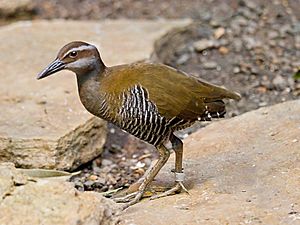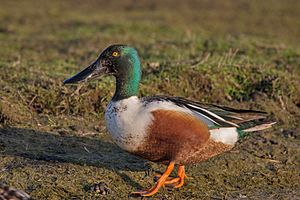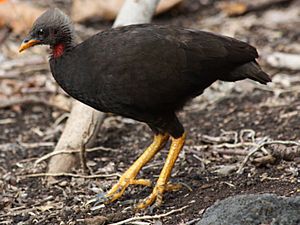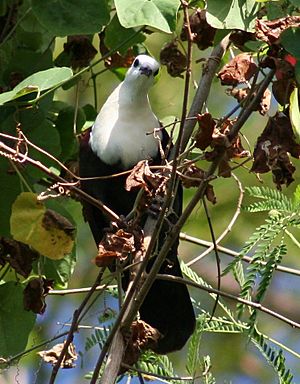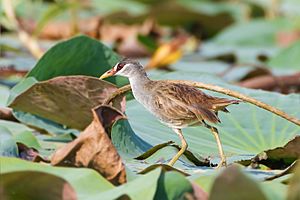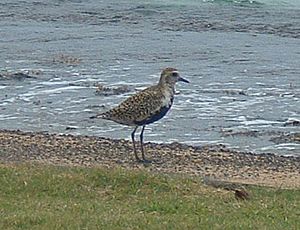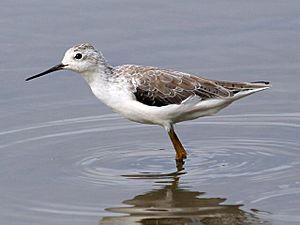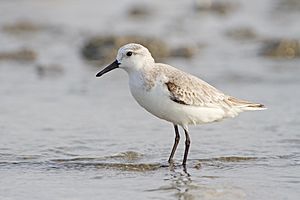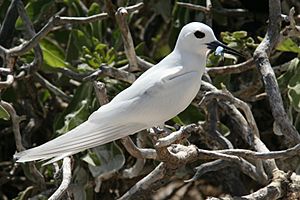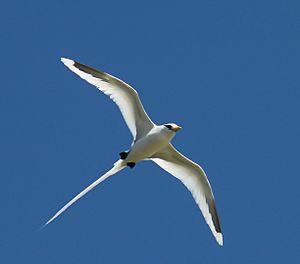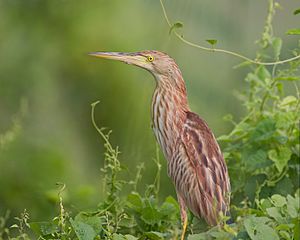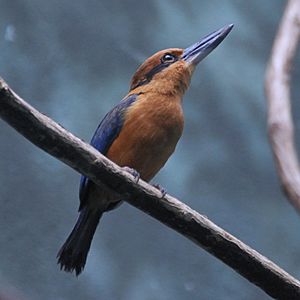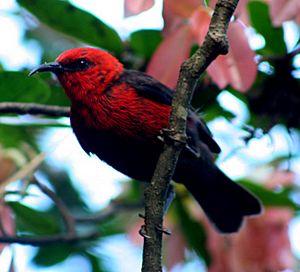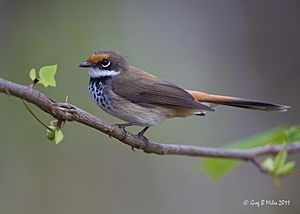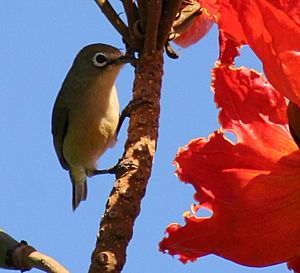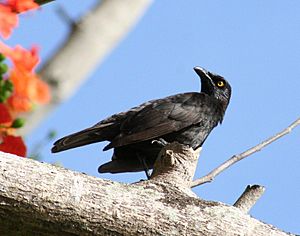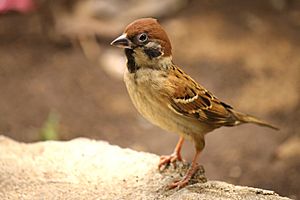List of birds of Guam facts for kids
Welcome to a list of the amazing birds found in Guam! As of August 2021, there have been 146 different types of birds seen here.
Some of these birds are very special:
- Eight species were brought to Guam by humans.
- 32 species are rare visitors or just pass through by accident.
- Three species are found only in Guam (endemic). Sadly, one of these is now extinct, and two others only live in special breeding programs, with plans to bring them back to the wild.
- Five species used to live in Guam but are now gone from the island, though they still exist elsewhere.
This list follows the bird classification from The Clements Checklist of Birds of the World, 2022 edition.
You'll see some special tags next to the bird names. Here's what they mean:
- A (Accidental): This bird rarely visits Guam by chance.
- End (Endemic): This bird lives only in Guam naturally.
- E (Extinct): This bird no longer exists anywhere.
- EW (Extinct in the wild): This bird only lives in special care, like zoos.
- I (Introduced): Humans brought this bird to Guam.
- Ex (Extirpated): This bird no longer lives in Guam, but it can be found elsewhere.
Contents
- Ducks, Geese, and Waterfowl
- Megapodes
- Pheasants, Grouse, and Allies
- Pigeons and Doves
- Cuckoos
- Swifts
- Rails, Gallinules, and Coots
- Stilts and Avocets
- Oystercatchers
- Plovers and Lapwings
- Sandpipers and Allies
- Pratincoles and Coursers
- Gulls, Terns, and Skimmers
- Tropicbirds
- Northern Storm-Petrels
- Shearwaters and Petrels
- Frigatebirds
- Boobies and Gannets
- Herons, Egrets, and Bitterns
- Osprey
- Hawks, Eagles, and Kites
- Owls
- Kingfishers
- Rollers
- Falcons and Caracaras
- Honeyeaters
- Fantails
- Drongos
- Monarch Flycatchers
- Crows, Jays, and Magpies
- Reed Warblers and Allies
- Swallows
- White-eyes
- Starlings
- Old World Flycatchers
- Waxbills, Munias, and Allies
- Old World Sparrows
- Wagtails and Pipits
- See also
Ducks, Geese, and Waterfowl
Order: Anseriformes Family: Anatidae
This family includes ducks, geese, and swans. These birds are built for water! They have webbed feet, flat bills, and oily feathers that shed water easily.
- Tundra swan, Cygnus columbianus (A)
- Garganey, Spatula querquedula (A)
- Northern shoveler, Spatula clypeata (A)
- Gadwall, Mareca strepera
- Eurasian wigeon, Mareca penelope
- American wigeon, Mareca americana
- Eastern spot-billed duck, Anas zonorhyncha (A)
- Mallard, Anas platyrhynchos
- Northern pintail, Anas acuta (A)
- Green-winged teal, Anas crecca
- Common pochard, Aythya ferina (A)
- Tufted duck, Aythya fuligula
- Greater scaup, Aythya marila (A)
- Surf scoter, Melanitta perspicillata (A)
Megapodes
Order: Galliformes Family: Megapodiidae
Megapodes are chunky, chicken-like birds with small heads and big feet. Most live in jungles and are brown or black.
- Micronesian scrubfowl, Megapodius laperouse (Ex)
Pheasants, Grouse, and Allies
Order: Galliformes Family: Phasianidae
This family includes quails, partridges, and pheasants. They are usually plump birds with broad, short wings.
- Blue-breasted quail, Coturnix chinensis (I)
- Black francolin, Francolinus francolinus (I) (Ex?)
- Red junglefowl, Gallus gallus (I)
Pigeons and Doves
Order: Columbiformes Family: Columbidae
Pigeons and doves are birds with stout bodies, short necks, and slender bills.
- Rock pigeon, Columba livia (I)
- Philippine collared-dove, Streptopelia dusumieri (I)
- White-throated ground dove, Alopecoenas xanthonurus
- Mariana fruit-dove, Ptilinopus roseicapilla (Ex)
Cuckoos
Order: Cuculiformes Family: Cuculidae
This family includes cuckoos and roadrunners. These birds have slim bodies, long tails, and strong legs.
- Chestnut-winged cuckoo, Clamator coromandus (A)
- Long-tailed koel, Urodynamis taitensis (A)
Swifts
Order: Caprimulgiformes Family: Apodidae
Swifts are small birds that spend most of their lives flying. They have very short legs and usually only perch on vertical surfaces. Many have long, swept-back wings.
- White-throated needletail, Hirundapus caudacutus (A)
- Uniform swiftlet, Aerodramus vanikorensis
- Mariana swiftlet, Aerodramus bartschi
- Caroline Islands swiftlet, Aerodramus inquietus
- Pacific swift, Apus pacificus
Rails, Gallinules, and Coots
Order: Gruiformes Family: Rallidae
This large family includes rails, crakes, and coots. They usually live in thick plants near water, like lakes or swamps. They are often shy and hard to spot. Most have strong legs and long toes for walking on soft ground. They tend to have short, rounded wings and are not strong fliers. The Guam rail was once extinct in the wild. Now, it has been brought back to Rota and Cocos Island near Guam.
- Guam rail, Gallirallus owstoni (End)
- Eurasian moorhen, Gallinula chloropus
- Eurasian coot, Fulica atra (A)
- White-browed crake, Poliolimnas cinereus (Ex)
Stilts and Avocets
Order: Charadriiformes Family: Recurvirostridae
This family includes avocets and stilts. Stilts have extremely long legs and long, thin, straight bills.
- Black-winged stilt, Himantopus himantopus
Oystercatchers
Order: Charadriiformes Family: Haematopodidae
Oystercatchers are large, noisy birds, similar to plovers. They have strong bills that they use to open molluscs.
- Eurasian oystercatcher, Haematopus ostralegus (A)
Plovers and Lapwings
Order: Charadriiformes Family: Charadriidae
This family includes plovers and lapwings. They are small to medium-sized birds with compact bodies and short, thick necks. They are found in open areas worldwide, often near water.
- Black-bellied plover, Pluvialis squatarola
- Pacific golden-plover, Pluvialis fulva
- Lesser sand-plover, Charadrius mongolus
- Greater sand-plover, Charadrius leschenaultii
- Kentish plover, Charadrius alexandrinus
- Common ringed plover, Charadrius hiaticula
- Little ringed plover, Charadrius dubius
Sandpipers and Allies
Order: Charadriiformes Family: Scolopacidae
This is a large family of shorebirds, including sandpipers, curlews, and snipes. Most of these birds eat small bugs they find in mud or soil. Their different leg and bill lengths allow many species to feed in the same places without competing for food.
- Bristle-thighed curlew, Numenius tahitiensis
- Whimbrel, Numenius phaeopus
- Little curlew, Numenius minutus
- Far Eastern curlew, Numenius madagascariensis
- Eurasian curlew, Numenius arquata
- Bar-tailed godwit, Limosa lapponica
- Black-tailed godwit, Limosa limosa
- Ruddy turnstone, Arenaria interpres
- Great knot, Calidris tenuirostris
- Red knot, Calidris canutus (A)
- Ruff, Calidris pugnax
- Sharp-tailed sandpiper, Calidris acuminata
- Curlew sandpiper, Calidris ferruginea
- Temminck's stint, Calidris temminckii (A)
- Long-toed stint, Calidris subminuta
- Red-necked stint, Calidris ruficollis
- Sanderling, Calidris alba
- Dunlin, Calidris alpina
- Pectoral sandpiper, Calidris melanotos
- Long-billed dowitcher, Limnodromus scolopaceus
- Latham's snipe, Gallinago hardwickii (A)
- Common snipe, Gallinago gallinago
- Swinhoe's snipe, Gallinago megala
- Terek sandpiper, Xenus cinereus
- Wilson's phalarope, Phalaropus tricolor (A)
- Common sandpiper, Actitis hypoleucos
- Gray-tailed tattler, Tringa brevipes
- Wandering tattler, Tringa incana
- Common greenshank, Tringa nebularia
- Marsh sandpiper, Tringa stagnatilis
- Wood sandpiper, Tringa glareola
- Common redshank, Tringa totanus
Pratincoles and Coursers
Order: Charadriiformes Family: Glareolidae
Pratincoles have short legs, very long pointed wings, and long forked tails. They are unusual because they catch insects while flying, much like swallows.
- Oriental pratincole, Glareola maldivarum
Gulls, Terns, and Skimmers
Order: Charadriiformes Family: Laridae
This family includes gulls, terns, and skimmers. Gulls are usually gray or white with black marks. They have strong bills and webbed feet. Terns are often gray or white with black heads. Most terns dive for fish. Many terns live a long time, some over 30 years!
- Black-headed gull, Chroicocephalus ridibundus
- Laughing gull, Leucophaeus atricilla (A)
- Slaty-backed gull, Larus schistisagus (A)
- Brown noddy, Anous stolidus
- Black noddy, Anous minutus
- White tern, Gygis alba
- Sooty tern, Onychoprion fuscatus
- Little tern, Sternula albifrons
- Gull-billed tern, Gelochelidon nilotica (A)
- White-winged tern, Chlidonias leucopterus
- Whiskered tern, Chlidonias hybrida
- Black-naped tern, Sterna sumatrana
- Common tern, Sterna hirundo
- Great crested tern, Thalasseus bergii
Tropicbirds
Order: Phaethontiformes Family: Phaethontidae
Tropicbirds are slender white birds of tropical oceans. They have very long central tail feathers. Their heads and long wings have black markings.
- White-tailed tropicbird, Phaethon lepturus
- Red-tailed tropicbird, Phaethon rubricauda
Northern Storm-Petrels
Order: Procellariiformes Family: Hydrobatidae
These birds are related to petrels and are the smallest seabirds. They eat tiny sea creatures and small fish from the water's surface while hovering. Their flight can be fluttering, like a bat.
- Leach's storm-petrel, Hydrobates leucorhous
- Matsudaira's storm-petrel, Hydrobates matsudairae
Shearwaters and Petrels
Order: Procellariiformes Family: Procellariidae
This group includes medium-sized "true petrels." They have nostrils that are joined together and a long outer wing feather.
- Juan Fernandez petrel, Pterodroma externa
- Tahiti petrel, Pseudobulweria rostrata
- Streaked Shearwater, Calonectris leucomelas
- Wedge-tailed shearwater, Ardenna pacificus
- Short-tailed shearwater, Ardenna tenuirostris
- Newell's shearwater, Puffinus newelli (A)
- Tropical shearwater, Puffinus bailloni
Frigatebirds
Order: Suliformes Family: Fregatidae
Frigatebirds are large seabirds found over tropical oceans. They are big, black and white, or all black, with long wings and deeply forked tails. Males have colorful throat pouches that can inflate. They don't swim or walk well and can't take off from flat ground. They have the largest wingspan for their body weight of any bird, allowing them to stay in the air for over a week!
- Great frigatebird, Fregata minor
Boobies and Gannets
Order: Suliformes Family: Sulidae
This family includes gannets and boobies. Both are medium to large coastal seabirds that dive headfirst into the water to catch fish.
- Masked booby, Sula dactylatra
- Brown booby, Sula leucogaster
- Red-footed booby, Sula sula
Herons, Egrets, and Bitterns
Order: Pelecaniformes Family: Ardeidae
This family includes bitterns, herons, and egrets. Herons and egrets are medium to large wading birds with long necks and legs. Bitterns are usually shorter-necked and more cautious. When they fly, members of this family pull their necks back, unlike storks or ibises.
- Yellow bittern, Ixobrychus sinensis
- Black bittern, Ixobrychus flavicollis (A)
- Gray heron, Ardea cinerea
- Great egret, Ardea alba
- Intermediate egret, Ardea intermedia
- Little egret, Egretta garzetta
- Pacific reef-heron, Egretta sacra
- Cattle egret, Bubulcus ibis
- Chinese pond-heron, Ardeola bacchus (A)
- Striated heron, Butorides striata
- Black-crowned night-heron, Nycticorax nycticorax
Osprey
Order: Accipitriformes Family: Pandionidae
This family has only one species, the osprey. The osprey is a medium-large raptor that specializes in eating fish. It can be found all over the world.
- Osprey, Pandion haliaetus
Hawks, Eagles, and Kites
Order: Accipitriformes Family: Accipitridae
This family includes hawks, eagles, and kites. These birds of prey have strong, hooked beaks to tear meat from their prey. They also have powerful legs, sharp talons, and excellent eyesight.
- Gray-faced buzzard, Butastur indicus (A)
- Chinese goshawk, Accipiter soloensis
- Black kite, Milvus migrans
Owls
Order: Strigiformes Family: Strigidae
Typical owls are mostly solitary birds of prey that hunt at night. They have large eyes that face forward, good hearing, a hawk-like beak, and a circle of feathers around each eye called a facial disk.
- Short-eared owl, Asio flammeus
Kingfishers
Order: Coraciiformes Family: Alcedinidae
Kingfishers are medium-sized birds with large heads, long pointed bills, short legs, and stubby tails. There are plans to bring the Guam kingfisher back to the wild as of early 2020.
- Common kingfisher, Alcedo atthis (A)
- Guam kingfisher, Todirhamphus cinnamominus (End) (EW)
- Mariana kingfisher, Todirhamphus albicilla (A)
- Belted kingfisher, Megaceryle alcyon (A)
Rollers
Order: Coraciiformes Family: Coraciidae
Rollers are similar in size and shape to crows, but they are more closely related to kingfishers. They are colorful birds, mostly blue and brown.
- Dollarbird, Eurystomus orientalis (A)
Falcons and Caracaras
Order: Falconiformes Family: Falconidae
This family includes falcons. They are different from hawks and eagles because they kill their prey with their beaks, not their talons.
- Eurasian kestrel, Falco tinnunculus
- Peregrine falcon, Falco peregrinus
Honeyeaters
Order: Passeriformes Family: Meliphagidae
Honeyeaters are a large family of small to medium-sized birds. They are most common in Australia and New Guinea. They feed on nectar and look similar to other nectar-eating birds.
- Micronesian myzomela, Myzomela rubratra (Ex)
Fantails
Order: Passeriformes Family: Rhipiduridae
Fantails are small birds that eat insects. They are experts at catching bugs while flying.
- Rufous fantail, Rhipidura rufifrons (Ex)
Drongos
Order: Passeriformes Family: Dicruridae
Drongos are mostly black or dark gray, sometimes with shiny metallic colors. They have long, forked tails. They have short legs and sit very upright when perched. They catch insects in the air or from the ground.
- Black drongo, Dicrurus macrocercus (I)
Monarch Flycatchers
Order: Passeriformes Family: Monarchidae
Monarch flycatchers are small to medium-sized birds that eat insects. They hunt by catching bugs in flight.
- Guam flycatcher, Myiagra freycineti (*E)
Crows, Jays, and Magpies
Order: Passeriformes Family: Corvidae
This family includes crows, ravens, and jays. Corvids are larger than average songbirds, and some of the bigger species are very smart.
- Mariana crow, Corvus kubaryi
Reed Warblers and Allies
Order: Passeriformes Family: Acrocephalidae
This family is a group of small songbirds that eat insects. Most of them look plain, but many have unique songs.
- Nightingale reed warbler, Acrocephalus luscinia (E)
Swallows
Order: Passeriformes Family: Hirundinidae
This family is built for catching food in the air. They have slender bodies, long pointed wings, and short bills with wide mouths. Their feet are made for perching, not walking.
- Barn swallow, Hirundo rustica
White-eyes
Order: Passeriformes Family: Zosteropidae
White-eyes are small birds that are mostly plain, often greenish-olive. Many species have a white ring around each eye, which is how they got their name.
- Bridled white-eye, Zosterops conspicillatus (Ex)
- Rota white-eye, Zosterops rotensis (End)
Starlings
Order: Passeriformes Family: Sturnidae
Starlings are small to medium-sized songbirds. They fly strongly and directly and often gather in large groups. They prefer open areas and eat insects and fruit. Their feathers are usually dark with a metallic shine.
- Micronesian starling, Aplonis opaca
Old World Flycatchers
Order: Passeriformes Family: Muscicapidae
The Old World flycatchers are a large family of small songbirds. These birds mainly eat insects from trees, and many catch their prey while flying.
- Narcissus flycatcher, Ficedula narcissina (A)
Waxbills, Munias, and Allies
Order: Passeriformes Family: Estrildidae
The birds in this family are small songbirds from tropical parts of the Old World. They like to be in groups and often live in colonies. They eat seeds and have short, thick, pointed bills. They are similar in shape and habits but have many different feather colors and patterns.
- Chestnut munia, Lonchura atricapilla (I)
Old World Sparrows
Order: Passeriformes Family: Passeridae
Old World sparrows are small songbirds. They are generally small, plump, brown, or gray birds with short tails and strong beaks. Sparrows eat seeds, but they also eat small insects.
- Eurasian tree sparrow, Passer montanus (I)
Wagtails and Pipits
Order: Passeriformes Family: Motacillidae
This family includes wagtails and pipits. They are slender songbirds with medium to long tails. They eat insects from the ground in open areas.
- Gray wagtail, Motacilla cinerea (A)
- Eastern yellow wagtail, Motacilla tschutschensis (A)
- White wagtail, Motacilla alba (A)
See also
- List of birds
- Lists of birds by region


